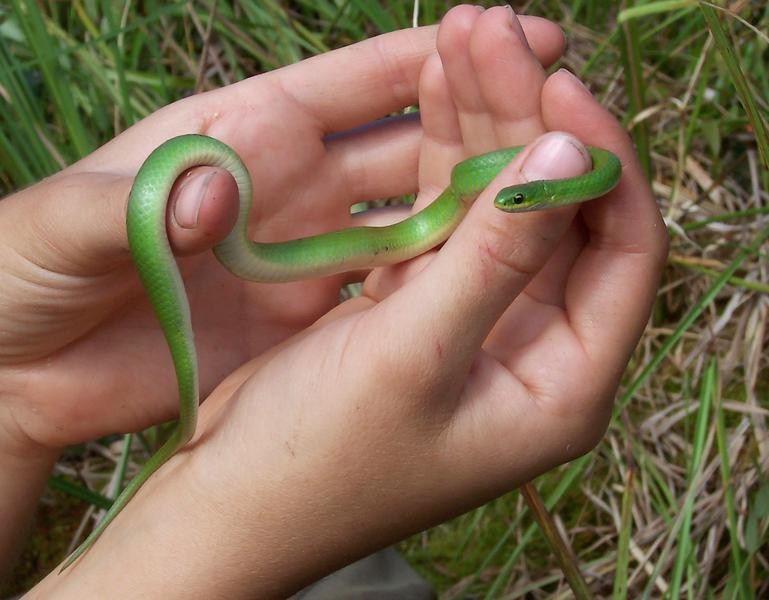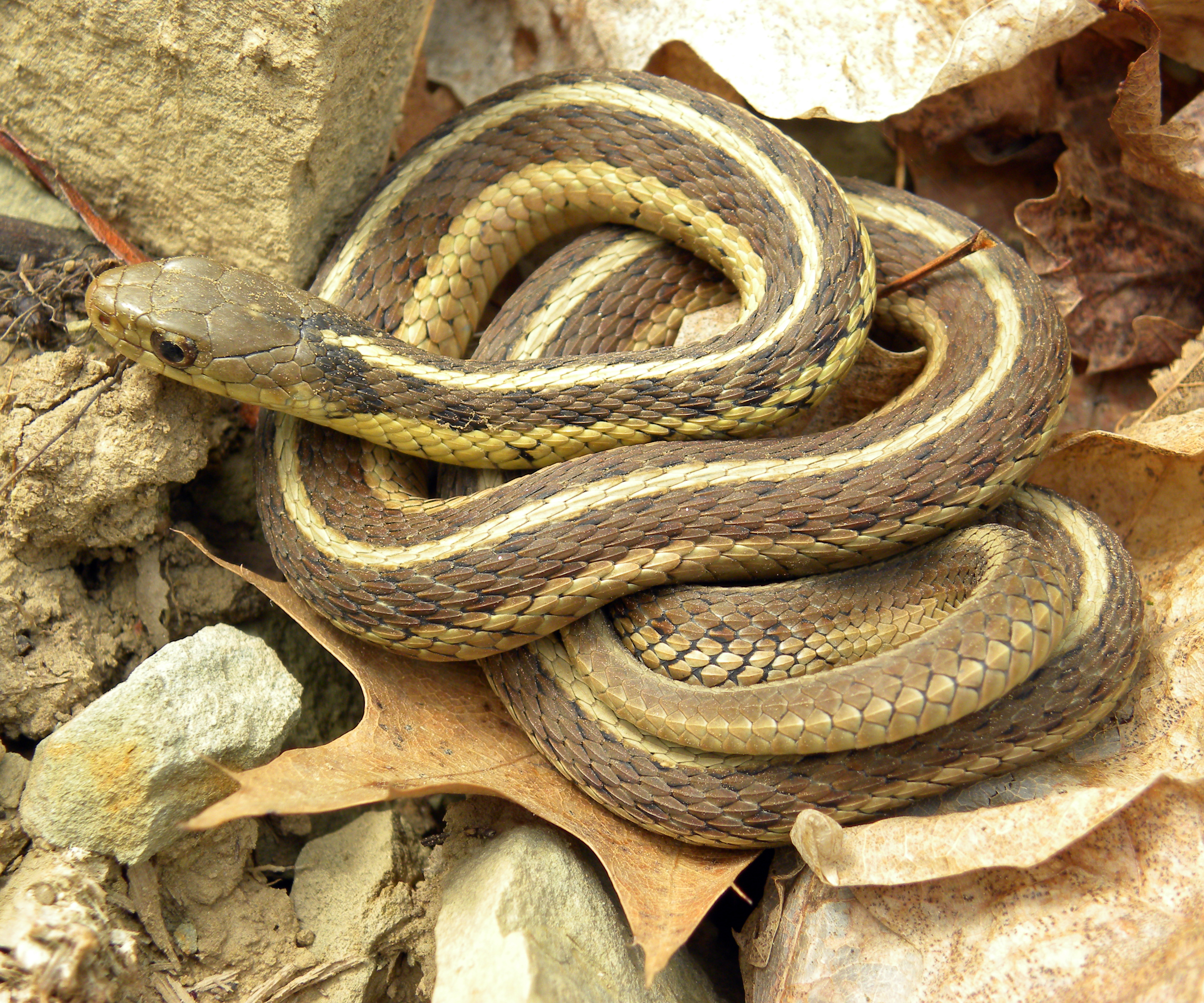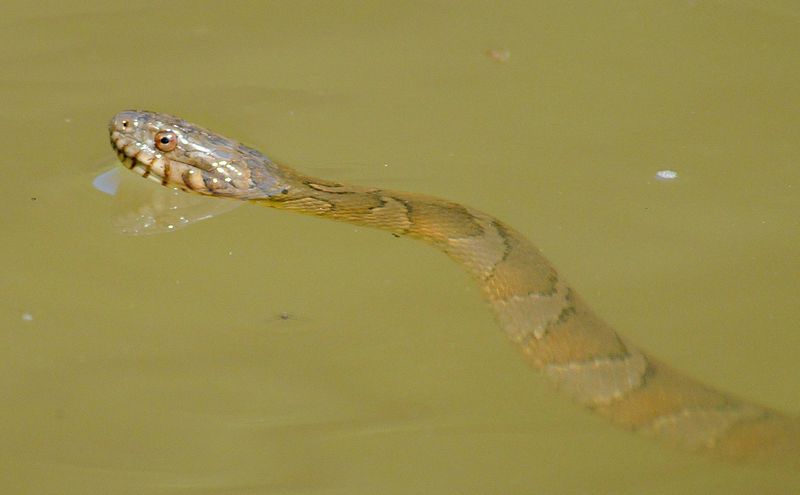Reptiles 103 Chapter 1
Non-Venomous Snakes
The vast majority of the snakes you’re likely to encounter around the pond are both enormously beneficial and completely harmless, and overall are not too damaging to pond or water feature systems. Of course, if you’re one of those people that gets uncomfortable even thinking about the Serpentes, as the family is known, you will certainly disagree, and if you are a full-blown herpetophobe, a person with a pathological fear of snakes, you should probably stop reading this right now. On the other hand, even when they’re making people uncomfortable they tend to do much more good than harm, eliminating much more problematic mice, rats and other small rodents. That’s not to say they won’t catch and eat your fish, frogs and other pond inhabitants on occasion, but snakes that occasionally visit are rarely major problems. All snakes can swim, but the ones you’re most likely to run into around the backyard pond are the harmless Green Snakes, the Garter Snakes and North America’s largest species, the Water Snakes.

The North American Green Snake
Green Snakes are small, fast and docile, and the two North American species are found across the entire continent, preferring moist environments. Only about 20” long fully grown, these pretty serpents eat mostly insects, although they have been known to take small frogs and snails as well.
The Garter Snakes are one of the most common visitors to the pond, for good reason – the 27 species found here are the most common reptiles in North America, with the widest distribution, ranging from Panama as far north as Alaska. The Garters are strong swimmers that will flee to the water to escape predators, and they will occasionally take small fish, but they are much more likely to prey on slugs, earthworms and insects, although one species, the Ribbon Snake, favors frogs. Because they rarely bite, they are often collected as pets, which has led to drop populations in some areas. When threatened they will typically hide their heads and wave their tails while discharging a foul smelling liquid from the anus.

The Garter Snake
The Water Snakes are the largest in North America, with some species reaching well over 4’ in length and as thick as your arm in girth. These snakes get a bad rap for two reasons – first, they are big and aggressive, often standing their ground rather than fleeing from people, and they will deliver a painful, though harmless, bite if cornered, and second, they are sometimes mistaken for venomous snakes. The photo shows a young Northern Water Snake with color, stripes and blotches that bear a superficial resemblance to a Copperhead or Cottonmouth. (See next section to compare photos.) Water Snakes vary greatly in color, often becoming an almost featureless black when older, so it’s a better idea to look at the shape of the head, which is a much narrower tapered oval than the big broad arrowhead of the Water Vipers.

The Northern Water Snake
So what do you do if you have snakes in the pond? Well, first off, DON’T MESS WITH IT. The only way you’re going to get bit by any snake is if you go harassing it, it’s certainly not going to mess with you. One of the most effective methods to discourage them from visiting is to eliminate or drastically reduce the amount of plant material in and around your pond. Snakes absolutely do not like the wide open spaces and prefer to keep to thick vegetation and shadows. Keep your landscaping well-manicured and snakes will find another place to hang out.
The vast majority of the snakes you’re likely to encounter around the pond are both enormously beneficial and completely harmless, and overall are not too damaging to pond or water feature systems. Of course, if you’re one of those people that gets uncomfortable even thinking about the Serpentes, as the family is known, you will certainly disagree, and if you are a full-blown herpetophobe, a person with a pathological fear of snakes, you should probably stop reading this right now. On the other hand, even when they’re making people uncomfortable they tend to do much more good than harm, eliminating much more problematic mice, rats and other small rodents. That’s not to say they won’t catch and eat your fish, frogs and other pond inhabitants on occasion, but snakes that occasionally visit are rarely major problems. All snakes can swim, but the ones you’re most likely to run into around the backyard pond are the harmless Green Snakes, the Garter Snakes and North America’s largest species, the Water Snakes.

The North American Green Snake
Green Snakes are small, fast and docile, and the two North American species are found across the entire continent, preferring moist environments. Only about 20” long fully grown, these pretty serpents eat mostly insects, although they have been known to take small frogs and snails as well.
The Garter Snakes are one of the most common visitors to the pond, for good reason – the 27 species found here are the most common reptiles in North America, with the widest distribution, ranging from Panama as far north as Alaska. The Garters are strong swimmers that will flee to the water to escape predators, and they will occasionally take small fish, but they are much more likely to prey on slugs, earthworms and insects, although one species, the Ribbon Snake, favors frogs. Because they rarely bite, they are often collected as pets, which has led to drop populations in some areas. When threatened they will typically hide their heads and wave their tails while discharging a foul smelling liquid from the anus.

The Garter Snake
The Water Snakes are the largest in North America, with some species reaching well over 4’ in length and as thick as your arm in girth. These snakes get a bad rap for two reasons – first, they are big and aggressive, often standing their ground rather than fleeing from people, and they will deliver a painful, though harmless, bite if cornered, and second, they are sometimes mistaken for venomous snakes. The photo shows a young Northern Water Snake with color, stripes and blotches that bear a superficial resemblance to a Copperhead or Cottonmouth. (See next section to compare photos.) Water Snakes vary greatly in color, often becoming an almost featureless black when older, so it’s a better idea to look at the shape of the head, which is a much narrower tapered oval than the big broad arrowhead of the Water Vipers.

The Northern Water Snake
So what do you do if you have snakes in the pond? Well, first off, DON’T MESS WITH IT. The only way you’re going to get bit by any snake is if you go harassing it, it’s certainly not going to mess with you. One of the most effective methods to discourage them from visiting is to eliminate or drastically reduce the amount of plant material in and around your pond. Snakes absolutely do not like the wide open spaces and prefer to keep to thick vegetation and shadows. Keep your landscaping well-manicured and snakes will find another place to hang out.




